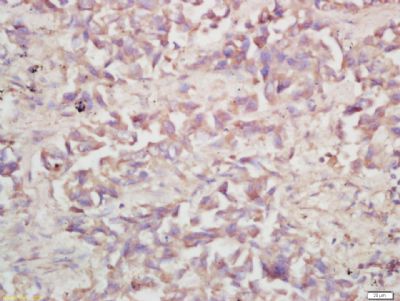ATP6V0A1 Polyclonal Antibody
Purified Rabbit Polyclonal Antibody (Pab)
- 产品详情
- 实验流程
Application
| IHC-P, IHC-F, IF, ICC, E |
|---|---|
| Primary Accession | Q93050 |
| Reactivity | Rat, Pig, Dog, Bovine |
| Host | Rabbit |
| Clonality | Polyclonal |
| Calculated MW | 96413 Da |
| Physical State | Liquid |
| Immunogen | KLH conjugated synthetic peptide derived from human V-ATPase A1 |
| Epitope Specificity | 41-140/837 |
| Isotype | IgG |
| Purity | affinity purified by Protein A |
| Buffer | 0.01M TBS (pH7.4) with 1% BSA, 0.02% Proclin300 and 50% Glycerol. |
| SUBCELLULAR LOCATION | Cytoplasmic vesicle membrane; Multi-pass membrane protein. Melanosome. Note=Coated vesicle. Identified by mass spectrometry in melanosome fractions from stage I to stage IV. |
| SIMILARITY | Belongs to the V-ATPase 116 kDa subunit family. |
| SUBUNIT | The V-ATPase is a heteromultimeric enzyme composed of at least thirteen different subunits. It has a membrane peripheral V1 sector for ATP hydrolysis and an integral V0 for proton translocation. The V1 sector comprises subunits A-H, whereas V0 includes subunits a, d, c, c', and c''. |
| Important Note | This product as supplied is intended for research use only, not for use in human, therapeutic or diagnostic applications. |
| Background Descriptions | The subunit of the vacuolar proton pump is a V-ATPase that has two different isoforms. The type I isoform contains an 18-base pair insert and is expressed in brain, whereas the truncated type II isoform is more widely expressed, including lung, kidney and spleen. The subunit of the vacuolar proton pump is located in clathrin-coated vesicles and is also found in osteoclasts. It consists of two fundamental domains, a hydrophilic amino-terminus, which has greater than 30% charged residues, and a hydrophobic carboxy terminus, which contains at least six transmembrane regions. The proton pump functions in coupling ATP hydrolysis by the cytoplasmic subunits to proton translocation by the intramembranous components of the pump. The inactivation of the osteoclast-specific vacuolar proton ATPase subunit is responsible for the lack of the enzyme in the apical membranes of osteoclast cells in osteosclerotic mutant mice, thus preventing the resorption function of these cells and leading to the osteopetrotic phenotype. The subunit, which co-localizes with the late endosomal marker Rab7 on vacuolar membranes, is essential for vacuole formation by selective swelling of late endosomes. |
| Gene ID | 535 |
|---|---|
| Other Names | V-type proton ATPase 116 kDa subunit a1, V-ATPase 116 kDa subunit a1, Clathrin-coated vesicle/synaptic vesicle proton pump 116 kDa subunit, Vacuolar adenosine triphosphatase subunit Ac116, Vacuolar proton pump subunit 1, Vacuolar proton translocating ATPase 116 kDa subunit a isoform 1, ATP6V0A1, ATP6N1, ATP6N1A, VPP1 |
| Dilution | IHC-P=1:100-500,IHC-F=1:100-500,ICC=1:100-500,IF=1:100-500,ELISA=1:5000-10000 |
| Format | 0.01M TBS(pH7.4) with 1% BSA, 0.09% (W/V) sodium azide and 50% Glyce |
| Storage | Store at -20 °C for one year. Avoid repeated freeze/thaw cycles. When reconstituted in sterile pH 7.4 0.01M PBS or diluent of antibody the antibody is stable for at least two weeks at 2-4 °C. |
| Name | ATP6V0A1 |
|---|---|
| Synonyms | ATP6N1, ATP6N1A, VPP1 |
| Function | Subunit of the V0 complex of vacuolar(H+)-ATPase (V-ATPase), a multisubunit enzyme composed of a peripheral complex (V1) that hydrolyzes ATP and a membrane integral complex (V0) that transports protons across cellular membranes. V-ATPase is responsible for the acidification of various organelles, such as lysosomes, endosomes, the trans-Golgi network, and secretory granules, including synaptic vesicles (PubMed:33065002, PubMed:33833240, PubMed:34909687). In certain cell types, can be exported to the plasma membrane, where it is involved in the acidification of the extracellular environment (By similarity). Required for assembly and activity of the vacuolar ATPase (By similarity). Through its action on compartment acidification, plays an essential role in neuronal development in terms of integrity and connectivity of neurons (PubMed:33833240). |
| Cellular Location | Cytoplasmic vesicle, clathrin-coated vesicle membrane {ECO:0000250|UniProtKB:P25286}; Multi-pass membrane protein. Cytoplasmic vesicle, secretory vesicle, synaptic vesicle membrane {ECO:0000250|UniProtKB:P25286}; Multi-pass membrane protein. Melanosome. Note=Identified by mass spectrometry in melanosome fractions from stage I to stage IV |
Research Areas
For Research Use Only. Not For Use In Diagnostic Procedures.
Application Protocols
Provided below are standard protocols that you may find useful for product applications.
终于等到您。ABCEPTA(百远生物)抗体产品。
点击下方“我要评价 ”按钮提交您的反馈信息,您的反馈和评价是我们最宝贵的财富之一,
我们将在1-3个工作日内处理您的反馈信息。
如有疑问,联系:0512-88856768 tech-china@abcepta.com.























 癌症的基本特征包括细胞增殖、血管生成、迁移、凋亡逃避机制和细胞永生等。找到癌症发生过程中这些通路的关键标记物和对应的抗体用于检测至关重要。
癌症的基本特征包括细胞增殖、血管生成、迁移、凋亡逃避机制和细胞永生等。找到癌症发生过程中这些通路的关键标记物和对应的抗体用于检测至关重要。 为您推荐一个泛素化位点预测神器——泛素化分析工具,可以为您的蛋白的泛素化位点作出预测和评分。
为您推荐一个泛素化位点预测神器——泛素化分析工具,可以为您的蛋白的泛素化位点作出预测和评分。 细胞自噬受体图形绘图工具为你的蛋白的细胞受体结合位点作出预测和评分,识别结合到自噬通路中的蛋白是非常重要的,便于让我们理解自噬在正常生理、病理过程中的作用,如发育、细胞分化、神经退化性疾病、压力条件下、感染和癌症。
细胞自噬受体图形绘图工具为你的蛋白的细胞受体结合位点作出预测和评分,识别结合到自噬通路中的蛋白是非常重要的,便于让我们理解自噬在正常生理、病理过程中的作用,如发育、细胞分化、神经退化性疾病、压力条件下、感染和癌症。






